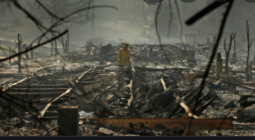Almost 8,000 US shootings attributed to unseasonable heat – study

Research suggests climate crisis may contribute to increased gun violence by pushing temperatures beyond normal ranges
Almost 8,000 shootings in US cities in recent years were attributable to unseasonably warm temperatures, according to a new study. The researchers said the work suggested the climate crisis could be contributing to increased gun violence by pushing temperatures beyond the normal ranges.
Shootings were already known to peak in summer, when people are outside more and when heat can increase aggression. But the new research took account of the season and showed that above average temperatures at any time of year increased the risk of shootings.
The study, the largest to date on the issue, assessed shooting in 100 US cities from 2015 to 2020. The scientists said the knowledge that unusually warm temperatures were linked to an increase in shooting incidents could enable community prevention measures to be targeted towards hotter days.
They also said increasing tree cover and green spaces can reduce gun violence, especially in the most deprived neighbourhoods. Both measures are known to cool urban areas and this link is now being investigated.
Firearm violence is a “leading public health crisis” in the US, the researchers said. The rate of gun murders has risen significantly since a historic low in 2014, and in 2020 firearms were the leading cause of death for children and adolescents.
“We saw a really consistent overall relationship between temperature and a higher risk of shootings,” said Dr Vivian Lyons, at the University of Washington, Seattle, who led the research. “When we are aware that firearm violence is more likely to happen on hotter days, regardless of the season, it can help inform violence prevention efforts.
“There is a concern I have, after the study, that firearm-related violence will rise as climate change continues.”
A study in 2020 reported that rising temperatures caused by global heating are likely to increase deaths from road crashes, violence, suicides and drowning, affecting young people most. Another study, published in 2018, found higher temperatures are linked to increasing rates of suicide.
The new research is published in the journal Jama Network Open. It found that in the 100 US cities with the highest number of firearm shootings, 7,973 shootings were attributable to above average temperatures, comprising 6.85% of all shootings. The shootings were firearm incidents with at least one person killed or injured. Suicides were not included.
The increased risk of gun violence was highest on days when temperatures were well above average, but the three-quarters of the shootings attributed to raised heat were on days only moderately above average.
“Our work suggests that climate change, which may elevate daily temperatures above normal ranges, may contribute to increased firearm violence,” the researchers said.
There are two main ideas to explain how warmer temperatures can increase shootings. Rising heat increases stress hormones, which can increase aggression. Higher temperatures can also increase time spent outside and social contacts, raising the potential for disputes. For most cities, the highest increased risk of shootings was between 29C (84F) and 32C.
Interventions known to reduce shootings include using “credible messengers” – people with lived experience of gun violence – to help those affected and help reduce the risk of violence. Lyons said knowing that unseasonably warm days increase the risk of firearm violence could help schedule their work.
The neighbourhood environment was also important, said Dr Jonathan Jay, at Boston University’s school of public health and part of the study team. “Gun violence disproportionately affects the neighbourhoods most impacted by segregation and long-term disinvestment – these have more abandoned buildings and vacant lots.”
He added: “Researchers have found that greening those spaces, replacing them with little local parks, reduces nearby gun violence. We have also found in our work that more tree canopy in a neighbourhood is associated with less gun violence.
“It’s noteworthy that each of those changes would also be expected to reduce temperatures. So further research could zoom in on ways that climate mitigation and environmental justice can intersect with gun violence prevention, in terms of investing in communities to make neighbourhoods more livable, and cooler and safer for the people.”
Dr Laurence Wainwright, at Oxford University, and not part of the research team, said: “This is important and somewhat sobering research that extends our understanding of the complex interplay between ambient temperature and human behaviour. Even fairly small changes in temperature can have a connection with biological, psychological and social factors that influence the way humans behave, including their propensity for violence.
“These findings significantly strengthen the hypothesis that temperature rises brought about due to human-induced climate change will have a connection with increased firearm violence in the US, and other countries, in the years ahead.”
Prof Seena Fazel, a forensic psychiatrist at Oxford, said: “The climate adaptation changes that are recommended, such as increasing green spaces, are important for many reasons. But from a violence prevention perspective, other approaches, including restricting guns, the availability of alcohol, healthcare services for substance misuse [are] likely to make a much greater contribution.”
cover photo: Chairs and bicycles lie abandoned after people fled the scene of a mass shooting at a Fourth of July celebration and parade in Highland Park, Illinois this year. Photograph: Tannen Maury/EPA





